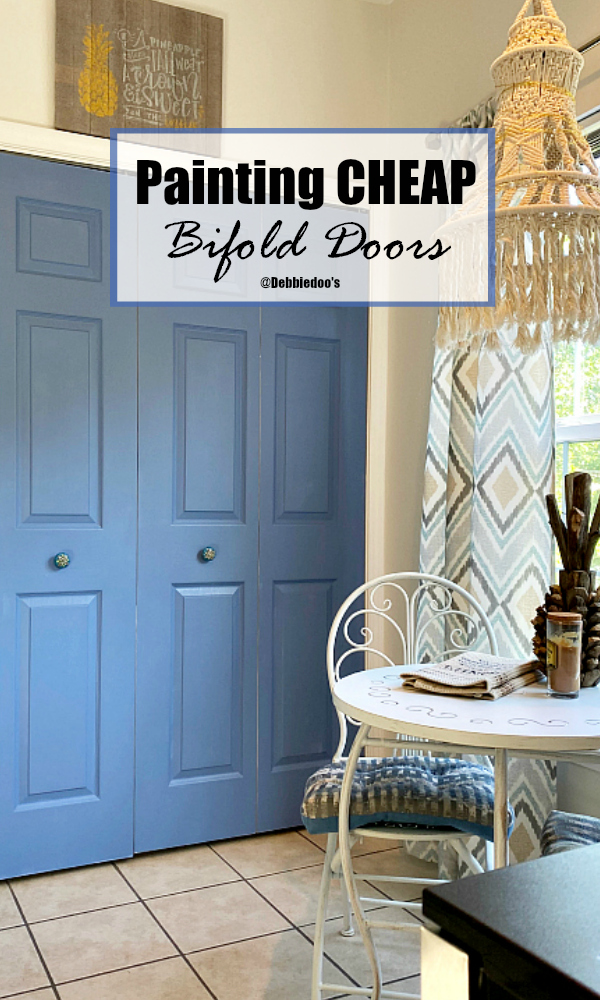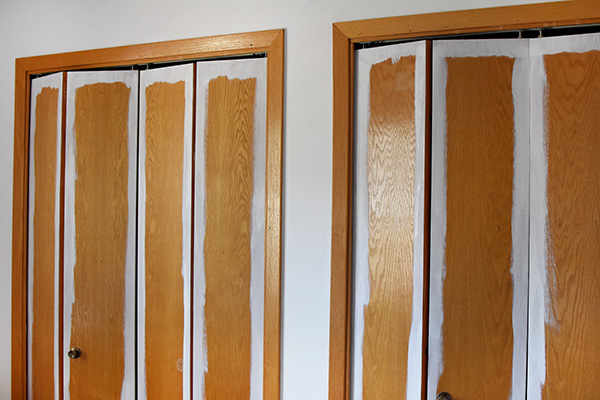To paint a bifold door, first, remove all hardware and sand the surface. Then, apply primer and two coats of paint, letting each coat dry completely before applying the next.
Painting a bifold door can be a simple and cost-effective way to update the look of a room. Whether you’re looking to match the color of your existing trim or add a pop of color to your space, painting your bifold door can be an easy DIY project.
Before beginning, it’s important to gather all necessary supplies and properly prepare the door for painting. With a little patience and attention to detail, you can achieve a professional-looking finish that will last for years to come. Follow these simple steps to learn how to paint a bifold door like a pro.

Credit: www.debbie-debbiedoos.com
Contents
Choosing The Right Paint
Choosing the right paint for your bifold door is crucial to achieving a professional and long-lasting finish. The type of paint and the finish you select will impact the overall look and durability of the door. Here’s what you need to consider when choosing the right paint for your bifold door.
Selecting The Paint Type
When selecting the paint type for your bifold door, it’s essential to choose a high-quality paint that is specifically formulated for use on doors and trim. Acrylic latex paints are a popular choice due to their durability and ease of application. They are also low in volatile organic compounds (VOCs), making them an environmentally friendly option. Semi-gloss or high-gloss acrylic latex paints are ideal for bifold doors as they provide a smooth, durable finish that is easy to clean.
Considering The Finish
The finish of the paint will not only affect the aesthetic appeal of your bifold door but also its ability to withstand daily wear and tear. Semi-gloss and high-gloss finishes are highly recommended for bifold doors as they are more resistant to moisture, stains, and scuffs. Additionally, these finishes are easier to clean, making them suitable for high-traffic areas such as entryways and hallways. Satin finishes are also an option, offering a subtle sheen while providing good durability.

Credit: www.delineateyourdwelling.com
Preparing The Bifold Door
When it comes to painting a bifold door, proper preparation is key to achieving a professional and lasting finish. Before you begin painting, it’s essential to prepare the surface of the door to ensure that the paint adheres well and the final result is smooth and flawless. This involves cleaning the surface and sanding the door to create a suitable base for the paint.
Cleaning The Surface
To start, clean the bifold door thoroughly to remove any dust, dirt, or grease that may affect the adhesion of the paint. Use a mild detergent and water solution to wash the door, then rinse it with clean water and allow it to dry completely. Ensure that all areas, including the edges and crevices, are free from any residue before proceeding to the next step.
Sanding The Door
After the door is clean and dry, sand the surface lightly using fine-grit sandpaper. This step helps to roughen the existing finish and create a slightly textured surface for the new paint to adhere to. Work in the direction of the wood grain and pay special attention to any areas with existing paint or varnish. The goal is to create a smooth and even surface without removing too much material. After sanding, wipe the door with a tack cloth to remove any dust or debris before applying the primer.
Protecting Surrounding Areas
Protecting the surrounding areas is crucial when painting a bifold door to prevent unwanted spills and splatters on adjacent surfaces. Here are essential tips to safeguard the surrounding areas before starting the painting process.
Taping Off Hardware
Use painter’s tape to carefully cover the hardware such as hinges, knobs, and locks to protect them from paint splatters. Ensure that the tape is securely attached to prevent any seepage underneath. This will help maintain the functionality and appearance of the door hardware.
Using Drop Cloths
Place drop cloths or plastic sheets on the floor and surrounding areas to catch any paint drips or spills. Secure the drop cloths with tape or weights to ensure they stay in place throughout the painting process. This will protect the floor and any nearby furniture from accidental paint damage.

Credit: www.delineateyourdwelling.com
Priming The Surface
When it comes to painting a bifold door, one of the crucial steps is priming the surface. Properly priming the door not only ensures a smooth and even paint application but also enhances the durability of the finish. In this section, we will discuss the importance of primer and the steps for applying it to the bifold door.
Importance Of Primer
Primer is essential for preparing the surface of the bifold door before applying the paint. It creates a uniform base, filling in any imperfections and creating a smooth surface for the paint to adhere to. Additionally, primer enhances the adhesion of the paint, preventing it from peeling or chipping over time. By sealing the surface, primer also helps to prevent moisture from penetrating the door, ultimately increasing its longevity.
Applying The Primer
Before applying the primer, ensure the bifold door is clean and free from dust, dirt, and any previous finishes. Use a mild detergent and water to clean the surface, and allow it to dry completely. Next, lightly sand the door to create a slightly rough texture, promoting better adhesion of the primer.
Apply the primer using a high-quality brush or roller, ensuring even coverage across the entire surface of the door. Pay special attention to the edges and corners, ensuring that the primer reaches all areas. Allow the primer to dry completely as per the manufacturer’s instructions before proceeding with the paint application.
Applying The Paint
Once you have prepped the bifold door, it’s time to apply the paint. This step requires attention to detail to achieve a smooth and professional finish.
Choosing The Right Tools
- Paintbrush: Use a high-quality, angled paintbrush for precision.
- Paint Roller: Opt for a roller with a smooth nap for even coverage.
- Painter’s Tape: Secure edges to prevent paint bleed.
- Drop Cloth: Protect the surrounding area from drips and spills.
Painting Techniques
- Start from the Top: Work from the top down to avoid drips.
- Even Strokes: Apply paint in smooth, even strokes for consistency.
- Thin Coats: Apply thin coats to prevent drips and ensure proper drying.
- Allow Drying Time: Allow each coat to dry completely before applying the next.
- Final Touches: Check for any missed spots and touch up as needed.
Drying And Re-coating
To paint a bifold door, it is important to properly dry and re-coat the surface between each layer of paint. This ensures a smooth and even finish, with no clumps or bumps. Use a high-quality paint and a steady hand to achieve a professional look.
Drying and Re-coating are crucial steps in the process of painting a bifold door. Properly allowing the paint to dry before applying additional coats ensures a smooth and durable finish. In this section, we will discuss Ensuring Proper Drying Time and Applying Additional Coats to achieve a professional result.Ensuring Proper Drying Time
- Allow adequate drying time between coats to prevent smudging or damage.
- Check the manufacturer’s instructions for recommended drying times.
- Avoid rushing the process to ensure the paint sets properly.
Applying Additional Coats
- Inspect the first coat for any imperfections before applying the next coat.
- Apply subsequent coats evenly to achieve a uniform finish.
- Ensure each coat is completely dry before applying the next one.
Adding Final Touches
Removing Tape And Protection
After the paint has dried, carefully remove the painter’s tape and any protective coverings from the door. Peel the tape off slowly to avoid any damage to the freshly painted surface. Inspect the edges to ensure clean lines and smooth transitions between the colors.
Reattaching Hardware
Now it’s time to reattach the hardware to the bifold door. Use a screwdriver to secure the hinges, handles, and any other accessories back onto the door. Make sure everything is aligned properly and tightly fastened for a professional and polished look.
Final Inspection
To ensure a flawless finish when painting a bifold door, a final inspection is crucial. Check for any missed spots or uneven areas, and make any necessary touch-ups before allowing the paint to dry completely.
Checking For Imperfections
Before finalizing the painting process, check the bifold door for any imperfections.
Inspect the surface carefully to ensure there are no missed spots or uneven paint distribution.
Look for drips, bubbles, or any other blemishes that may affect the overall appearance.
Touching Up As Needed
If you spot any imperfections, address them by touching up the paint.
Use a small brush to fix minor issues such as drips or uneven areas.
Apply a thin layer of paint to blend in with the rest of the door.
Complete the final inspection by reviewing the entire bifold door for a flawless finish.
Ensure all imperfections are corrected before considering the project complete.
With attention to detail, your painted bifold door will look professional and polished.
Frequently Asked Questions
What Kind Of Paint Do You Use On Bifold Doors?
Use a high-quality latex or acrylic paint for bifold doors. These paints are durable and provide a smooth finish.
How To Paint Bifold Closet Doors White?
To paint bifold closet doors white, first, remove the doors from the hinges. Clean and sand the surface. Apply a primer, then paint with a white enamel paint using a brush or roller. Let it dry completely before rehanging the doors.
Can You Paint Wooden Bifold Doors?
Yes, you can paint wooden bifold doors. Sand, prime, and paint with a brush or roller for a fresh look.
Can You Change The Color Of Bifold Doors?
Yes, you can change the color of bifold doors by sanding, priming, and painting them with a suitable paint.
Conclusion
Achieve a fresh look by painting your bifold door with these simple steps. Enhance your space with a pop of color or a classic finish. Don’t forget to prep, prime, and paint for a professional result. Transform your door and elevate your home decor effortlessly.
